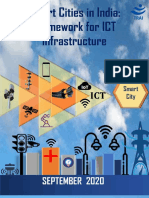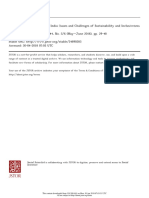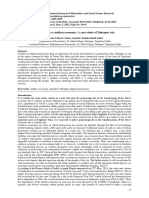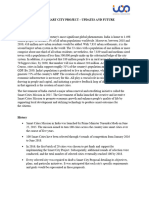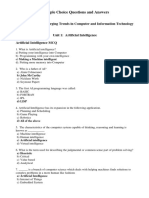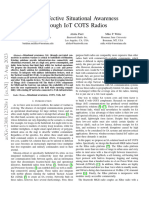A Study On Finding The Most Significant Indicators For Smart City Planning of Vadodara, Gujarat
A Study On Finding The Most Significant Indicators For Smart City Planning of Vadodara, Gujarat
Uploaded by
JagurteeCopyright:
Available Formats
A Study On Finding The Most Significant Indicators For Smart City Planning of Vadodara, Gujarat
A Study On Finding The Most Significant Indicators For Smart City Planning of Vadodara, Gujarat
Uploaded by
JagurteeOriginal Description:
Original Title
Copyright
Available Formats
Share this document
Did you find this document useful?
Is this content inappropriate?
Copyright:
Available Formats
A Study On Finding The Most Significant Indicators For Smart City Planning of Vadodara, Gujarat
A Study On Finding The Most Significant Indicators For Smart City Planning of Vadodara, Gujarat
Uploaded by
JagurteeCopyright:
Available Formats
© 2018 JETIR November 2018, Volume 5, Issue 11 www.jetir.
org (ISSN-2349-5162)
A Study on Finding the Most Significant
Indicators for Smart City Planning of
Vadodara, Gujarat
Ritika Kashyap1*, Prof. Jagruti Shah2
1
PG scholar, Infrastructure Engineering &Technology, B.V.M Engineering College
Vallabh Vidhyanagar, Anand, Gujarat, India.
2
Assistant Professor, Structure Engineering Department, B.V.M Engineering College, Vallabh
Vidhyanagar, Anand, Gujarat, India.
Abstract
Infrastructure sector is the key driver for the Indian economy and contributes about 5% of
its GDP. India’s current population as per census 2011 is 121 crores out of which 31% of
India’s population lives in urban areas and contributes 63% of India’s GDP. As population
is growing more people are migrating to urban areas in search of better livelihood. To
address the challenges of Urbanization and Urban Growth, Government of India has
initiated many programs like AMRUT, HRIDAY, JNNURM, Housing for all, Smart City
program etc. Smart city mission was initiated in 2015 and its mission is to empower the
cities socially, economically and technologically. It mainly focuses on basic amenities,
education, digitization, safety and security etc. This paper comprises of finding the smart
city indicator which will have more impact on the development of city by the study of
existing infrastructural facility of Vadodara city, Gujarat.
Keywords: Indicators, Infrastructure, Smart city, Urbanization, Vadodara
INTRODUCTION
Cities are flourishing due to growth in infrastructural facility. Infrastructure sector is highly
responsible for driving India’s overall development. According to planning commission,
infrastructure investments are estimated to touch 8% GDP. Almost 37% of the investment in
infrastructure comes from the private sector. India jumped 19 places to rank 35th among 160 countries
in World Bank's Logistics Performance Index (LPI) 2016 (source: lpi.worldbank.org). India’s current
population as per census 2011 is 121 crores out of which 31% of India’s population lives in urban
areas and contributes 63% of India’s GDP. Nearly 45.36 crore people are migrants in India, which is
around 37.8% of total population. The main reason for migration is urbanization.
Urbanization rate is increasing every day in India. Starting from 1901, only 11.4% people were living
in urban areas where as it has increased to 31.6% in 2011. It is expected that by 2030, 40.76%
population will be residing in urban areas. Sustainable urbanisation can only be achieved by managing
the migration of people. For solving these problems, government of India has initiated the smart city
mission. In this research work we have studied the basic infrastructural facilities that are available in
the Vadodara city and listed out the parameters which could be considered for designing and planning
of it as a smart city.
OBJECTIVES OF STUDY
To study existing infrastructure facility in context with smart city parameter for Vadodara
city.
To analyse smart city indicator which have more impact on development of smart city.
JETIRK006001 Journal of Emerging Technologies and Innovative Research (JETIR) www.jetir.org 1
© 2018 JETIR November 2018, Volume 5, Issue 11 www.jetir.org (ISSN-2349-5162)
STUDY OF EXISTING INFRASTRUCTURAL FACILITY: VADODARA CITY
In terms of population as well as in area, Vadodara is considered as the third largest city of Gujarat. In
1981, 7.34 lakhs people were residing in Vadodara city whereas, the present population is 16.70
lakhs, as per census 2011. It is estimated that by 2041, it will be reaching around 37.12 lakhs. For
accommodating this huge population, Government of India has initiated the smart city mission. From
all over the country total 100 cities were selected and from Gujarat, 6 cities were selected, and they
are Ahmedabad, Surat, Vadodara, Rajkot, Gandhinagar and Dahod.
Further study will be based on basic infrastructures like transportation, water availability, solid waste
management, energy, safety etc.
Transportation condition
Vadodara city is very well connected by rail, road and air. It has the first green airport in Gujarat
whereas stands second in India after Kochi. Vadodara Junction is one of the busiest junction of
Gujarat and around 358 train passes from here each day. It has around 1,680 km of paved road and
400 km of unpaved road. Internal road connectivity is good in the city but there is a need for
improvement in public transportation condition. Around 52 km of new road with width of 6-18 meter
has been added to existing 900 km of road. 80 km of roads are made wall to wall, out of existing 425
km and 71 km of footpath have been added to these roads. 90% of the internal roads are converted to
RCC roads. New flyovers have been constructed for the easy movement of traffic. Bus shelters have
been increased from 110 to 300 number for the benefit of city bus passengers. City police is now
using E-challan integrated with ANPR for good traffic management.
Availability of water
The water distributed in the city is around 380 MLD and 33% of it is supplied without pumping i.e.
through gravity hence saving the power required for pumping. 90% of the household in Vadodara
have water connections which are supplied through networks. VMC is ensuring quality monitoring in
all the wards of the city. At present in most parts of the city, the water is supplied only for 1 hr or even
less. To overcome this problem, they have introduced 24x7 water supply in 15% of the city
households. They have also succeeded in reducing the water wastage by 33-40%.
Solid waste management
Vadodara has initiated Swachh Vadodara movement in 2014 and various stakeholders, NGO’s and
people of the city have taken part in it. It has been declared as the 10th cleanest city in the country. The
waste produced in the city is almost 510 tons per day and the garbage collection is done door to door
by GPS enabled monitoring system. The waste collected mostly comprises of organic matter, inert
material and other waste. In 2012, 150 MT of solid waste is disposed by scientific disposal method
which now has been increased to 350 MT. VMC has introduced energy generation from solid waste
with 200 MT capacity. There is also an online grievance redressal system which works 24x7.
Safety and security
In 2011, Vadodara was ranked as one of the safest city in the country. Public participation in
maintaining, prompt crime reporting, empowering women for self-defense, disseminating traffic
awareness through various initiatives like Suraksha SETU program, Vadodara Traffic & Community
Policing program. Introduced ABHYAM which is a helpline and response system for women working
24x7. Cognizable cases have been reduced from 27801 to 19317. 220 CCTV’s cameras have been
installed in the city till now for ensuring safety and security.
Availability of energy
The city of Vadodara is having surplus power supply. 100% houses in the city have been electrified
and efficient metering and user-friendly billing system is adopted. VMC have reduced the
transmission and distribution losses from 10.44% to 6.41%. Unscheduled outages have also been
reduced through efficient distribution system. Almost 70% of the street lights have been converted to
LED’s for power saving. There has been an increase in the usage of renewable energy for ex. canal-
top solar panel and roof top solar panel. This will reduce pressure on the demand for non-renewable
energy sources.
JETIRK006001 Journal of Emerging Technologies and Innovative Research (JETIR) www.jetir.org 2
© 2018 JETIR November 2018, Volume 5, Issue 11 www.jetir.org (ISSN-2349-5162)
FINDINGS
In the last 3 years, much efforts have been made by the city to improve livability, sustainability and
economic development. From the service level benchmarking of Vadodara city, it is found out that
there is a considerable service level gap in urban mobility, including public transport, pedestrian
facilities, parking etc. Significant improvement is also required for water supply, sewerage, solid
waste and storm water drainage management.
ANALYSING SMART CITY PARAMETERS IN CONTEXT TO VADODARA CITY
Many definitions of smart city exist today and hence there is no universally accepted definition for it.
The concept of smart city, varies all over the world considering the level of development, keenness to
adopt changes and reforms, resources and aspirations of the residents of city. For the designing of
smart city, planners have decided 4 major factors for the comprehensive development and they are-
economic, institutional, physical and social infrastructures.
A smart city should fulfil certain objectives for the urban development like promoting cities which
have core infrastructure, provides a decent quality of life to its residents and have sustainable
environment. The city should be promoting mixed land use and have housing opportunities for every
section of the society. It should have open spaces and walkable localities. Various transportation
options should be available making it cost effective and citizen friendly. Overall the city should have
an identity of its own.
Albino et al. (2015) stated that initially in 1999 the first definition for smart city was based on three
parameters- technology, people and community but with time these parameters are changing, and new
dimensions are being formed. [1]
Aditya et al. (2015) analyzed that IOT (internet of things) is a way for building smart cities. They
believed that by interconnecting everything the information can be shared easily, and decisions can be
made in a faster way. [4]
Anthopoulos et al. (2015) identified six common dimensions, namely people, government, economy,
mobility, environment and living which could be used for building smart city. [2]
Chourabi et al. (2012) acknowledged eight critical factors of smart city initiatives: management and
organization, technology, governance, policy context, people and communities, economy, built
infrastructure, and natural environment. Technology can be considered as a meta-factor in smart city
development, since it could heavily influence each of the other seven factors. [6]
Nam et al. (2011) highlighted three main dimensions for building smart city- technology, people, and
institutions. They highlighted the fact that social factors other than smart technologies are central to
smart cities. There lies a connection between social and technical factors of services and physical
environments in a city. [8]
MAJOR FINDINGS
A smart city has various dimensions and its performance can be evaluated based on these dimensions.
Cities differ because of infrastructural, cultural and governmental terms, so there is no one, universal
evaluation model for smart cities. By the through study and from the smart city guidelines provided
we have identified 9 indicators which could be used for the development of smart city.
Economic factors- It is mostly related to different costs and investments made for the
development of an area or city.
Environmental Factors- The use of technology to increase sustainability, livability of a city
and to better manage natural resources.
Innovation and learning factor- A new or creative learning which helps in generation or
development of technologies or applications.
Information Communication & Technological Factors- Networks play a crucial role in
making smart cities a reality. It includes wireless infrastructure (fiber optic channels, Wi-Fi
networks, wireless hotspots, kiosks) service-oriented information systems.
JETIRK006001 Journal of Emerging Technologies and Innovative Research (JETIR) www.jetir.org 3
© 2018 JETIR November 2018, Volume 5, Issue 11 www.jetir.org (ISSN-2349-5162)
Mobility Factors- Helpful for reducing congestion and fostering faster, greener, and cheaper
transportation options
Operational & Managerial Factors- It is concerned with converting materials and labor
into goods and services as efficiently as possible to maximize the profit.
Physical Factors- It refers to the basic physical structures required for an economy to
function and survive, such as transportation networks, a power grid and sewerage and waste
disposal systems.
Political Factors- These are those factors which are confined to government’s norm. They
have the power to change results. It can also affect government policies at local to federal
level.
Social factors- These are related to human development and growth. It includes factors like
education, recreational facilities, safety etc. Focuses mainly on upliftment of people.
CONCLUSION
This paper explored that how the urbanization is increasing every day and people are transferring to
urban areas in search of better livelihood. Vadodara is also facing the same scenario, and hence it is
selected for the smart city mission. For finalizing the smart city parameters, we have studied the
existing facilities available in the city. This paper provides the existing infrastructural facility
available in the city and from the study, nine parameters have been selected which could be helpful
for designing Vadodara as a smart city. Further study will include evaluation of priority index for the
infrastructural planning of smart city.
REFERENCES
1. Albino V., Berardi U., Dangelico R., "Smart Cities: Definitions, Dimensions, Performance,
and Initiatives", Journal of Urban Technology, Febuary 2015, 1-19.
2. Anthopoulos L., Janssen M., Weerakkody V., "Comparing Smart Cities with Different
Modeling Approaches", International World Wide Web Conference, May 2015, 525-528.
3. Azim A., AghaJani R., "Designing Smart Cities", Indian Journal of Fundamental and Applied
Life Sciences, ISSN: 2231– 6345 (Online), Volume 4, 2014, 146-153.
4. Aditya Vasisht, Priyanka N, “Smart Cities”, International Journal of Engineering Science
Invention ISSN (Online): 2319 – 6734, ISSN (Print): 2319 – 6726 Volume 4 Issue 9
September 2015 PP.43-49
5. Bhagat S., Shah P., Patel M., "Smart Cities in Context to Urban Development", International
Journal of Civil, Structural, Environmental and Infrastructure Engineering Research and
Development, ISSN 2249-6866 (print) / ISSN 2249-7978 (online), Volume 4, Issue 1,
Febuary 2014, 41-48.
6. Chourabi H., Nam T., Walker S., Gil-Garcia J., Mellouli S., Nahon K., Pardo T., Scholl H.,
"Understanding Smart Cities: An Integrative Framework", IEEE - Hawaii International
Conference on System Sciences, 2012, 2289-2297.
7. Giffinger R., Fertner Christian., Kramar Hans., Kalasek Robert., Pichler-Milanovic N.,
Meijers E., “Smart Cities - Ranking of European medium-sized cities”, Centre of Regional
Science, Vienna University of Technology, October 2007, 1-29.
8. Nam T., Pardo T., "Conceptualizing Smart City with Dimensions of Technology, People, and
Institutions", International Conference on Digital Government Research, ISBN: 978-1-4503-
0762-8, June 2011, 282-291.
JETIRK006001 Journal of Emerging Technologies and Innovative Research (JETIR) www.jetir.org 4
You might also like
- Analysis of Status and Performance of Smart City Mission in India An OverviewNo ratings yetAnalysis of Status and Performance of Smart City Mission in India An Overview6 pages
- Allahabad As A Smart City: Swot Analysis: January 2016No ratings yetAllahabad As A Smart City: Swot Analysis: January 201619 pages
- Project Report Industrial Visit AKS UniversityNo ratings yetProject Report Industrial Visit AKS University18 pages
- Preparation of Model Urban Action Plan For Effective Environmental Management: A Case Study From A.PNo ratings yetPreparation of Model Urban Action Plan For Effective Environmental Management: A Case Study From A.P9 pages
- Urban Infrastructure: Submitted To:-Dhara Ma'amNo ratings yetUrban Infrastructure: Submitted To:-Dhara Ma'am23 pages
- Addressing The Key Issues in Emerging World With The Promotion of Smart and Sustainable Practices: A Case of Sarabha Nagar, LudhianaNo ratings yetAddressing The Key Issues in Emerging World With The Promotion of Smart and Sustainable Practices: A Case of Sarabha Nagar, Ludhiana5 pages
- Delhi Technological University: Engineering Economics (Hu 202) Assignment No. 1 Topic: Smart CityNo ratings yetDelhi Technological University: Engineering Economics (Hu 202) Assignment No. 1 Topic: Smart City6 pages
- Analysis of Urban Agriculture Sustainability in Metropolitan JakartaNo ratings yetAnalysis of Urban Agriculture Sustainability in Metropolitan Jakarta6 pages
- Implementation Study of Smart Mobility and Smart Living in Commuter Line at Sudirman Station, Central JakartaNo ratings yetImplementation Study of Smart Mobility and Smart Living in Commuter Line at Sudirman Station, Central Jakarta5 pages
- 2016HJSSVII II131 143AnjanSenSubhashAnandArunPratapMishraNo ratings yet2016HJSSVII II131 143AnjanSenSubhashAnandArunPratapMishra14 pages
- Is Urban Development in Gujarat Unhealthy?: June 2013No ratings yetIs Urban Development in Gujarat Unhealthy?: June 20137 pages
- Social Scientist Social Scientist: This Content Downloaded From 130.209.6.61 On Mon, 30 Apr 2018 07:03:31 UTCNo ratings yetSocial Scientist Social Scientist: This Content Downloaded From 130.209.6.61 On Mon, 30 Apr 2018 07:03:31 UTC21 pages
- Digital Payment As A Key Enabler of E-Government Services ANo ratings yetDigital Payment As A Key Enabler of E-Government Services A15 pages
- Smart City Trends and Innovations Shaping The Future of CitiesNo ratings yetSmart City Trends and Innovations Shaping The Future of Cities10 pages
- The Smart Village Model For Rural Area (Case Study: Banyuwangi Regency)No ratings yetThe Smart Village Model For Rural Area (Case Study: Banyuwangi Regency)11 pages
- Stages and Challenges in Implementation of Smart City Project, UdaipurNo ratings yetStages and Challenges in Implementation of Smart City Project, Udaipur6 pages
- An Overview of Madurai Smart City - HBRP PublicationNo ratings yetAn Overview of Madurai Smart City - HBRP Publication6 pages
- Extensive Reading - Passage - Week 7 - Slums and Future CitiesNo ratings yetExtensive Reading - Passage - Week 7 - Slums and Future Cities8 pages
- Building the Infrastructure for the FutureNo ratings yetBuilding the Infrastructure for the Future3 pages
- Smart Water and Wastewater Management With Smart City ChallengesNo ratings yetSmart Water and Wastewater Management With Smart City Challenges12 pages
- Smart Cities in India Practices Policies Current SNo ratings yetSmart Cities in India Practices Policies Current S14 pages
- Transition To A Cashless Economy: A Case Study of Dimapur CityNo ratings yetTransition To A Cashless Economy: A Case Study of Dimapur City7 pages
- Indias Smart City Project Update and Future 1No ratings yetIndias Smart City Project Update and Future 113 pages
- A Monthly Double-Blind Peer Reviewed Refereed Open Access International E-Journal - Included in The International Serial DirectoriesNo ratings yetA Monthly Double-Blind Peer Reviewed Refereed Open Access International E-Journal - Included in The International Serial Directories12 pages
- IET Wireless Sensor Systems - 2019 - Mohapatra - Detection and Avoidance of Water Loss Through Municipality Taps in IndiaNo ratings yetIET Wireless Sensor Systems - 2019 - Mohapatra - Detection and Avoidance of Water Loss Through Municipality Taps in India11 pages
- World Habitat Day 2023 and India's Urban Landscape: Why in News?No ratings yetWorld Habitat Day 2023 and India's Urban Landscape: Why in News?6 pages
- India's Urban Challenges and Smart Cities: A Contemporary StudyNo ratings yetIndia's Urban Challenges and Smart Cities: A Contemporary Study23 pages
- Evolution of Satellite Township Development in Pune: A Case StudyNo ratings yetEvolution of Satellite Township Development in Pune: A Case Study22 pages
- Question Bank Sustainable Urban Planning 2019 First YearNo ratings yetQuestion Bank Sustainable Urban Planning 2019 First Year2 pages
- A Review Paper On Effect of Urban Sprawl On The Development of Emerging Smart CityNo ratings yetA Review Paper On Effect of Urban Sprawl On The Development of Emerging Smart City5 pages
- Public Private Partnerships Frequently Asked Questions: Ministry of Planning and Investment (MPI) Government of Lao PDR100% (1)Public Private Partnerships Frequently Asked Questions: Ministry of Planning and Investment (MPI) Government of Lao PDR19 pages
- Impact of GIFT City & Brief Study of It's Infrastructure: Parmar Noel, Prof. Jagruti Shah, Jani Jenil, Paliwal MayankNo ratings yetImpact of GIFT City & Brief Study of It's Infrastructure: Parmar Noel, Prof. Jagruti Shah, Jani Jenil, Paliwal Mayank5 pages
- Integrated Solid Waste Management For Sustainability: A ReviewNo ratings yetIntegrated Solid Waste Management For Sustainability: A Review4 pages
- State of Enterprise IoT Security in North AmericaNo ratings yetState of Enterprise IoT Security in North America15 pages
- Design and Development of A Smart Garage Door SystemNo ratings yetDesign and Development of A Smart Garage Door System6 pages
- The Digitalisation of Supply Chain A ReviewNo ratings yetThe Digitalisation of Supply Chain A Review11 pages
- ETI 22618 UT1 Question Bank 2022-23 080323No ratings yetETI 22618 UT1 Question Bank 2022-23 08032331 pages
- Collision Avoidance Using Iot: Shiv Swarup, Shreyas M.S., Saathvik R. Khatavkar, Varun H.H., Rama Satish K. VNo ratings yetCollision Avoidance Using Iot: Shiv Swarup, Shreyas M.S., Saathvik R. Khatavkar, Varun H.H., Rama Satish K. V5 pages
- Introducing the Automatic Counting System Presentation Demo 1No ratings yetIntroducing the Automatic Counting System Presentation Demo 118 pages
- Citypulse d2.2 Smart City Framework v2.3No ratings yetCitypulse d2.2 Smart City Framework v2.350 pages
- Apps Alliance Global Developer Insights Report 2015No ratings yetApps Alliance Global Developer Insights Report 201539 pages
- Chen, Lin, Liu - Edge Computing Gateway of The Industrial Internet of Things Using Multiple Collaborative MicrocontrollersNo ratings yetChen, Lin, Liu - Edge Computing Gateway of The Industrial Internet of Things Using Multiple Collaborative Microcontrollers9 pages
- Device Edge Cloud Continuum Paradigms, Architectures and ApplicationsNo ratings yetDevice Edge Cloud Continuum Paradigms, Architectures and Applications234 pages
- List of Lab Experiments: Department of Electronics & Telecommunication Engg. SUBJECT: Internet of ThingsNo ratings yetList of Lab Experiments: Department of Electronics & Telecommunication Engg. SUBJECT: Internet of Things21 pages
- Amazon, Apple, Facebook & Google: Too Big To Fail, Too Big To RegulateNo ratings yetAmazon, Apple, Facebook & Google: Too Big To Fail, Too Big To Regulate29 pages
- Smart City Initiatives in Nay Pyi Taw: 2 ASEAN-Japan Smart Cities Network High Level MeetingNo ratings yetSmart City Initiatives in Nay Pyi Taw: 2 ASEAN-Japan Smart Cities Network High Level Meeting17 pages
- Cost-Effective Situational Awareness Through IoT CNo ratings yetCost-Effective Situational Awareness Through IoT C6 pages
- Analysis of Status and Performance of Smart City Mission in India An OverviewAnalysis of Status and Performance of Smart City Mission in India An Overview
- Allahabad As A Smart City: Swot Analysis: January 2016Allahabad As A Smart City: Swot Analysis: January 2016
- Preparation of Model Urban Action Plan For Effective Environmental Management: A Case Study From A.PPreparation of Model Urban Action Plan For Effective Environmental Management: A Case Study From A.P
- Addressing The Key Issues in Emerging World With The Promotion of Smart and Sustainable Practices: A Case of Sarabha Nagar, LudhianaAddressing The Key Issues in Emerging World With The Promotion of Smart and Sustainable Practices: A Case of Sarabha Nagar, Ludhiana
- Delhi Technological University: Engineering Economics (Hu 202) Assignment No. 1 Topic: Smart CityDelhi Technological University: Engineering Economics (Hu 202) Assignment No. 1 Topic: Smart City
- Analysis of Urban Agriculture Sustainability in Metropolitan JakartaAnalysis of Urban Agriculture Sustainability in Metropolitan Jakarta
- Implementation Study of Smart Mobility and Smart Living in Commuter Line at Sudirman Station, Central JakartaImplementation Study of Smart Mobility and Smart Living in Commuter Line at Sudirman Station, Central Jakarta
- 2016HJSSVII II131 143AnjanSenSubhashAnandArunPratapMishra2016HJSSVII II131 143AnjanSenSubhashAnandArunPratapMishra
- Is Urban Development in Gujarat Unhealthy?: June 2013Is Urban Development in Gujarat Unhealthy?: June 2013
- Social Scientist Social Scientist: This Content Downloaded From 130.209.6.61 On Mon, 30 Apr 2018 07:03:31 UTCSocial Scientist Social Scientist: This Content Downloaded From 130.209.6.61 On Mon, 30 Apr 2018 07:03:31 UTC
- Digital Payment As A Key Enabler of E-Government Services ADigital Payment As A Key Enabler of E-Government Services A
- Smart City Trends and Innovations Shaping The Future of CitiesSmart City Trends and Innovations Shaping The Future of Cities
- The Smart Village Model For Rural Area (Case Study: Banyuwangi Regency)The Smart Village Model For Rural Area (Case Study: Banyuwangi Regency)
- Stages and Challenges in Implementation of Smart City Project, UdaipurStages and Challenges in Implementation of Smart City Project, Udaipur
- An Overview of Madurai Smart City - HBRP PublicationAn Overview of Madurai Smart City - HBRP Publication
- Extensive Reading - Passage - Week 7 - Slums and Future CitiesExtensive Reading - Passage - Week 7 - Slums and Future Cities
- Smart Water and Wastewater Management With Smart City ChallengesSmart Water and Wastewater Management With Smart City Challenges
- Smart Cities in India Practices Policies Current SSmart Cities in India Practices Policies Current S
- Transition To A Cashless Economy: A Case Study of Dimapur CityTransition To A Cashless Economy: A Case Study of Dimapur City
- A Monthly Double-Blind Peer Reviewed Refereed Open Access International E-Journal - Included in The International Serial DirectoriesA Monthly Double-Blind Peer Reviewed Refereed Open Access International E-Journal - Included in The International Serial Directories
- IET Wireless Sensor Systems - 2019 - Mohapatra - Detection and Avoidance of Water Loss Through Municipality Taps in IndiaIET Wireless Sensor Systems - 2019 - Mohapatra - Detection and Avoidance of Water Loss Through Municipality Taps in India
- World Habitat Day 2023 and India's Urban Landscape: Why in News?World Habitat Day 2023 and India's Urban Landscape: Why in News?
- India's Urban Challenges and Smart Cities: A Contemporary StudyIndia's Urban Challenges and Smart Cities: A Contemporary Study
- Evolution of Satellite Township Development in Pune: A Case StudyEvolution of Satellite Township Development in Pune: A Case Study
- Question Bank Sustainable Urban Planning 2019 First YearQuestion Bank Sustainable Urban Planning 2019 First Year
- A Review Paper On Effect of Urban Sprawl On The Development of Emerging Smart CityA Review Paper On Effect of Urban Sprawl On The Development of Emerging Smart City
- Public Private Partnerships Frequently Asked Questions: Ministry of Planning and Investment (MPI) Government of Lao PDRPublic Private Partnerships Frequently Asked Questions: Ministry of Planning and Investment (MPI) Government of Lao PDR
- Impact of GIFT City & Brief Study of It's Infrastructure: Parmar Noel, Prof. Jagruti Shah, Jani Jenil, Paliwal MayankImpact of GIFT City & Brief Study of It's Infrastructure: Parmar Noel, Prof. Jagruti Shah, Jani Jenil, Paliwal Mayank
- Integrated Solid Waste Management For Sustainability: A ReviewIntegrated Solid Waste Management For Sustainability: A Review
- Design and Development of A Smart Garage Door SystemDesign and Development of A Smart Garage Door System
- Collision Avoidance Using Iot: Shiv Swarup, Shreyas M.S., Saathvik R. Khatavkar, Varun H.H., Rama Satish K. VCollision Avoidance Using Iot: Shiv Swarup, Shreyas M.S., Saathvik R. Khatavkar, Varun H.H., Rama Satish K. V
- Introducing the Automatic Counting System Presentation Demo 1Introducing the Automatic Counting System Presentation Demo 1
- Apps Alliance Global Developer Insights Report 2015Apps Alliance Global Developer Insights Report 2015
- Chen, Lin, Liu - Edge Computing Gateway of The Industrial Internet of Things Using Multiple Collaborative MicrocontrollersChen, Lin, Liu - Edge Computing Gateway of The Industrial Internet of Things Using Multiple Collaborative Microcontrollers
- Device Edge Cloud Continuum Paradigms, Architectures and ApplicationsDevice Edge Cloud Continuum Paradigms, Architectures and Applications
- List of Lab Experiments: Department of Electronics & Telecommunication Engg. SUBJECT: Internet of ThingsList of Lab Experiments: Department of Electronics & Telecommunication Engg. SUBJECT: Internet of Things
- Amazon, Apple, Facebook & Google: Too Big To Fail, Too Big To RegulateAmazon, Apple, Facebook & Google: Too Big To Fail, Too Big To Regulate
- Smart City Initiatives in Nay Pyi Taw: 2 ASEAN-Japan Smart Cities Network High Level MeetingSmart City Initiatives in Nay Pyi Taw: 2 ASEAN-Japan Smart Cities Network High Level Meeting
- Cost-Effective Situational Awareness Through IoT CCost-Effective Situational Awareness Through IoT C
